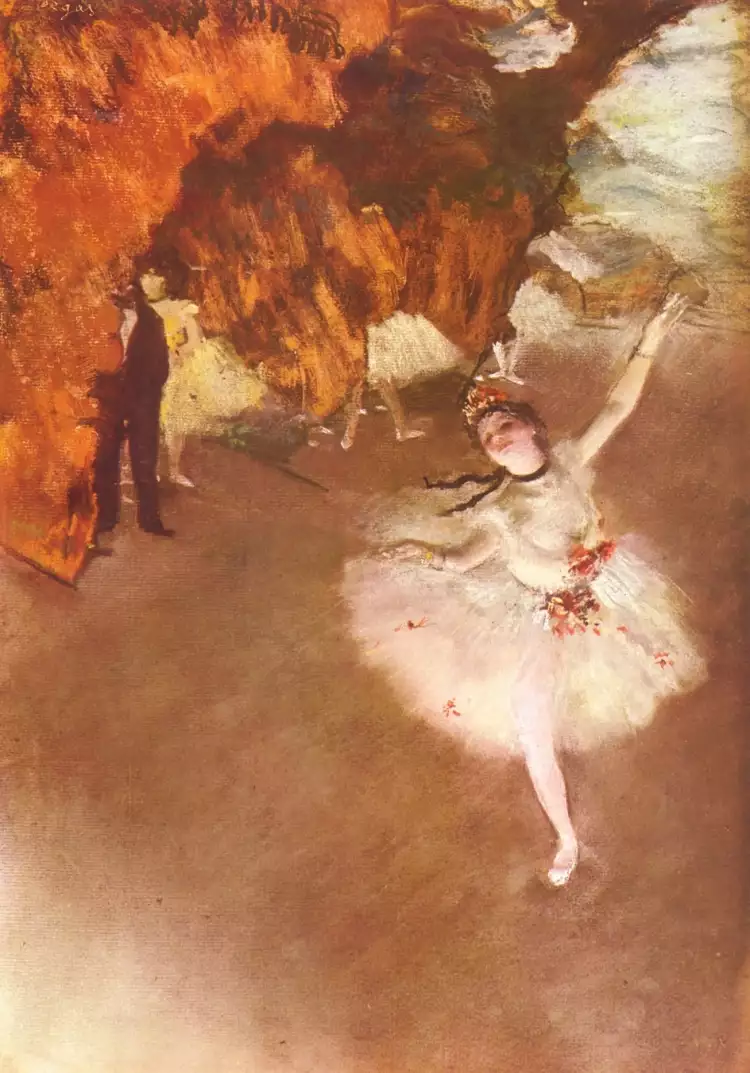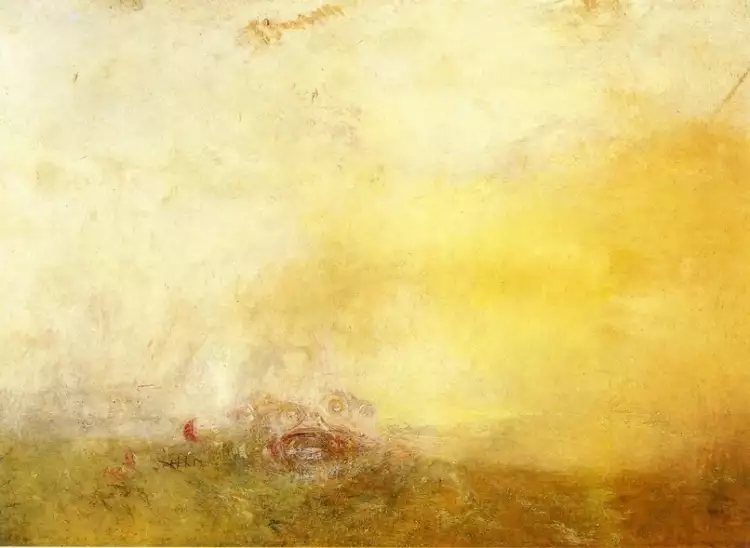
Impressionism in painting, or The Catchers of the Beautiful Moment
Impressionism is an influential, expansive, and groundbreaking movement in the art of the late 19th and early 20th centuries. Often, the history of painting is divided into periods before and after Impressionism. This movement laid the foundations for the visual art of the 20th century with all its numerous avant-garde styles. While Impressionist artwork now seems closer to the classical tradition than to contemporary art, for contemporaries, the ideas of Impressionists were like a fresh breeze entering the world of fading academicism and salon painting.
 Impressionism. Claude Monet. The Artist's Garden at Giverny, 1900
Impressionism. Claude Monet. The Artist's Garden at Giverny, 1900
Impressionism can indeed be compared to the gust of wind, the trembling of leaves, and the glints of sunlight on the sea ripples. The essence of this creative method lies in reflecting the variability of the surrounding reality. Impressionists aimed to move away from static depictions of the world and make paintings more vibrant. They sought to capture the movement that fills nature, convey changes in the air, shadows, and light in their works. An Impressionist artist tried to capture elusive moments and immortalize the mood of the moment.
 Impressionism. Pierre Auguste Renoir. Dance at Bougival, 1883
Impressionism. Pierre Auguste Renoir. Dance at Bougival, 1883
Impressionism is a term derived from the French word "impression". Looking at Impressionist paintings, it seems that they are painted with hurried strokes, as if the artist tried to quickly pour out their overflowing emotions onto the canvas. One of the first critics of Impressionism, Louis Leroy, even found this style to be careless. That's why he titled his critique of the Salon des Refusés, where the works of the first Impressionists were exhibited, "L'Exposition des impressionnistes," which can be translated as "Exhibition of Impressionists."
 Impressionism. Claude Monet. Impression, Sunrise, 1872
Impressionism. Claude Monet. Impression, Sunrise, 1872
Leroy sharpened his wit and criticism, but the term caught on and became art-historical. Now it's used without any irony, of course.
Impressionism. Pierre Auguste Renoir. Dance at Le moulin de la Galette, 1876
Characteristics of Impressionism
When looking at the masterpieces of Impressionism created by the masters of this movement, you can identify their common features:
- Concreteness of place and time of action. Impressionist paintings always capture a moment of "here and now," taking into account lighting, time of day, weather, and perspective.
- Emphasis on the essential (from the artist's point of view). When looking at Impressionist paintings, the viewer's gaze seems to be thrown into the crowd or onto nature along with the artist, extracting colors, silhouettes, emotions, and images from reality but not focusing on details.
- Ephemerality. The feeling arises that the world in the painting is alive, people are moving, rivers are flowing—and the image will change in a moment.
 Impressionism. Edgar Degas. Prima ballerina, 1878
Impressionism. Edgar Degas. Prima ballerina, 1878
- Visual effects. This sensation is emphasized by glimmers, flickering, trembling, ripples, and other markers of changeability.
- Liveliness, everydayness of subjects. As Impressionists "captured the moment," they abandoned traditional academic subjects—historical, mythological, religious. The main themes became landscapes and scenes from everyday life. They painted contemporaneity, not shying away from simple and even "low" (from an academic perspective) scenes.
Impressionism. Édouard Manet. Plum Brandy, circa 1877
The democratic approach to choosing subjects scandalized the conservative public: instead of familiar Venuses, they were offered a look at dancers and prostitutes, instead of subjects filled with lofty ideals, they saw picnics and taverns.
 Impressionism. Édouard Manet. At the Père Lathuille Restaurant, 1879
Impressionism. Édouard Manet. At the Père Lathuille Restaurant, 1879
Perhaps landscapes were the most innocuous, but even here, the innovative Impressionist artists managed to disturb the traditionalists. Let's understand why.
 Impressionism. Alfred Sisley. Spring Lawn in Bea, 1880
Impressionism. Alfred Sisley. Spring Lawn in Bea, 1880
Impressionism is a new technique and a new perspective
When answering the question of what Impressionism is, it's important to emphasize that it's more than just a style. It's a philosophy, an ideological stance, a set of artistic methods that encompassed various areas of culture. It wasn't just that Impressionist painters started creating paintings with certain stylistic features. They offered a new perspective on the world by stepping out of the studio walls.
 Impressionism. Camille Pissarro. Entrance to the Village of Voisins, 1872
Impressionism. Camille Pissarro. Entrance to the Village of Voisins, 1872
For centuries, artists painted narrative canvases, portraits, and even landscapes within studios. This prevented them from capturing nuances related to natural lighting. For instance, when painting a sunset, an artist conveyed a theoretical, generalized idea of a sunset.
 Impressionism. Édouard Manet. The Croquet Game, 1873
Impressionism. Édouard Manet. The Croquet Game, 1873
Striving to capture and transpose fleeting impressions onto canvas, the Impressionists contrasted the studio with plein air painting. Tube paints emerged during this time, allowing artists to work in nature or on city streets.
 Impressionism. Camille Pissarro. The Boulevard Montmartre on a winter morning, 1897
Impressionism. Camille Pissarro. The Boulevard Montmartre on a winter morning, 1897
This allowed them to paint the world exactly as the artist saw it at the moment of creating the painting. But it turned out that traditional painting methods were not suitable for such work! This necessitated the creation of a special technique. Its features included:
- Abandoning distinct outlines.
- Abandoning detail and meticulous rendering (though sometimes parts of the image on Impressionist paintings are detailed while others are not).
- Abandoning glazing, which involves applying semi-transparent paint over the base color, as is typical in the classical school.
- Using bold, energetic brushstrokes known as "étude" strokes.
- Separate application of brushstrokes.
- Avoiding paint mixing — this is one of the key features of the Impressionist technique.
Impressionist painters rejected the use of a traditional palette and created shades by applying strokes of pure colors close to each other (interestingly, they barely used black paint, creating dark areas through visual effects). Hence, Impressionist works need to be viewed from a certain distance.
 Impressionism. Edgar Degas. The Blue Dancers, 1897
Impressionism. Edgar Degas. The Blue Dancers, 1897
However, the innovative technique was only part of the changes that Impressionism brought to painting. It turned out that under natural lighting at different times of the day, in shadow or under bright sunlight, objects don't always appear as we are accustomed to seeing them in a room or in classical paintings. For instance, when the sun shines in our eyes, we squint, and this alters perception, and if the sky is filled with a storm front, the world gains contrasting clarity.
Claude Monet wonderfully demonstrated this in his series of paintings "Haystacks."
 Impressionism. Claude Monet. Haystacks (1), 1890-1891
Impressionism. Claude Monet. Haystacks (1), 1890-1891
 Impressionism. Claude Monet. Haystacks (2), 1890-1891
Impressionism. Claude Monet. Haystacks (2), 1890-1891
 Impressionism. Claude Monet. Haystacks (3), 1890-1891
Impressionism. Claude Monet. Haystacks (3), 1890-1891
 Impressionism. Claude Monet. Haystacks (4), 1890-1891
Impressionism. Claude Monet. Haystacks (4), 1890-1891
Impressionist artists started portraying things as they saw them at the moment of creating the painting, breaking away from conventions. For example, red berries could take on a violet hue, and a figure receding into the distance could partially dissolve in the veil of mist or rain.
 Impressionism. Claude Monet. Woman with a Parasol, 1875
Impressionism. Claude Monet. Woman with a Parasol, 1875
On the other hand, reflecting the world "as it is" wasn't the same in Impressionism as in realism. The role of subjectivity in perception increased, which later gained even more prominence among post-impressionists, "wild" fauvists, and representatives of other innovative movements.
 Impressionism. Claude Monet. Storm off the Belle-Ile Coast, 1886
Impressionism. Claude Monet. Storm off the Belle-Ile Coast, 1886
Great Impressionist Artists
The first Impressionist notes appeared in the landscapes of renowned masters. Precursors of Impressionism include Eugène Delacroix and William Turner.
 Impressionism. Eugène Delacroix. The Sea from the Heights of Dieppe, 1852
Impressionism. Eugène Delacroix. The Sea from the Heights of Dieppe, 1852
 Impressionism. William Turner. Sunrise with sea monsters, 1845
Impressionism. William Turner. Sunrise with sea monsters, 1845
Interestingly, the works of Katsushika Hokusai and other Japanese landscape artists also influenced the development of Impressionism.
As a distinct movement, Impressionism began to take shape in the 1860s, and the first exhibition that brought together innovators was held in 1874. It was during this time that Louis Leroy published his satirical article, giving the movement its name.
 Impressionism. Édouard Manet. In the garden, 1870
Impressionism. Édouard Manet. In the garden, 1870
The most significant influences on the development of this new style were:
- Édouard Manet and Claude Monet - two great Impressionists with similar last names. Their acquaintance began with a mix-up at an exhibition and an argument (Manet was congratulated for Monet's success), but this amusing situation marked the beginning of a strong friendship.
- Edgar Degas, a chronicler of the theater world, opera, and café scenes. He was one of the few Impressionist painters who avoided working en plein air.
- Pierre-Auguste Renoir - the first among the artists of the movement to gain recognition.
- Alfred Sisley - a master of lyrical landscapes.
 Impressionism. Pierre Auguste Renoir. Female Nude, 1876
Impressionism. Pierre Auguste Renoir. Female Nude, 1876
Camille Pissarro, Frédéric Bazille, Gustave Caillebotte, and the artist Berthe Morisot made significant contributions to the development of Impressionist painting.
 Impressionism. Camille Pissarro. The Boulevard Montmartre at Night, 1897
Impressionism. Camille Pissarro. The Boulevard Montmartre at Night, 1897
Are you impressed by the works of these masters? Share your impressions in the comments. And if you feel the desire to become a collector of artworks by Impressionist artists, take part in online auctions on the VeryImportantLot website. This is an opportunity to become the owner of paintings whose value increases with each passing year.

 Live Fine and Applied Аrt Auction No.8 of the Antiqon trading platform
Live Fine and Applied Аrt Auction No.8 of the Antiqon trading platform  Glamour in photography is a beautiful genre with elements of elegance and luxury
Glamour in photography is a beautiful genre with elements of elegance and luxury  Special auction Faussner collection
Special auction Faussner collection  Drawing: essence, types, techniques, and a brief history
Drawing: essence, types, techniques, and a brief history  Lorie Company - silver in the Art Nouveau style
Lorie Company - silver in the Art Nouveau style  The top 10 most famous photographers in the world - the best photo artists of all time
The top 10 most famous photographers in the world - the best photo artists of all time  Photography is an art accessible to everyone
Photography is an art accessible to everyone  The Timeless Charm of Vintage Ephemera: A Collector's Guide
The Timeless Charm of Vintage Ephemera: A Collector's Guide  English Silver Tableware - History, Fashion, and Styles
English Silver Tableware - History, Fashion, and Styles  Animalism is a popular genre in painting from prehistoric times
Animalism is a popular genre in painting from prehistoric times